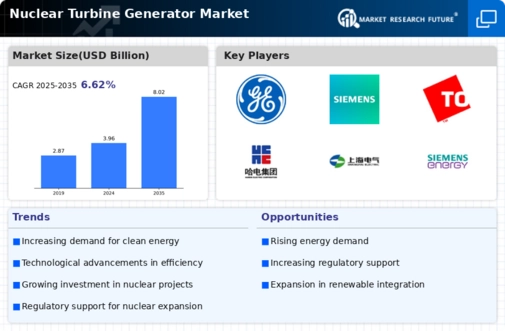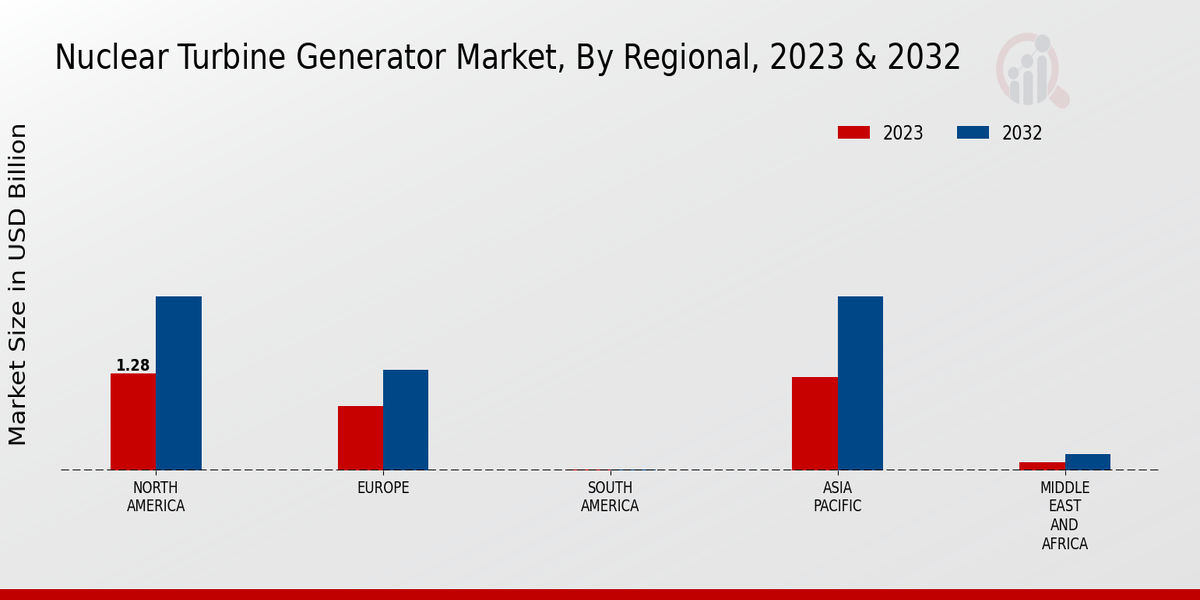Market Growth Projections
The Global Nuclear Turbine Generator Market Industry is projected to experience substantial growth over the next decade. With a market value of 3.96 USD Billion in 2024, it is expected to reach 8.02 USD Billion by 2035. This growth trajectory indicates a compound annual growth rate (CAGR) of 6.62% from 2025 to 2035. The increasing focus on sustainable energy solutions, coupled with advancements in nuclear technology and supportive government policies, is likely to drive this expansion. As the world continues to seek reliable and low-carbon energy sources, the Global Nuclear Turbine Generator Market Industry is poised for a promising future.
Technological Advancements
Technological innovations play a pivotal role in shaping the Global Nuclear Turbine Generator Market Industry. Recent advancements in turbine design and materials have enhanced efficiency and reliability, making nuclear power plants more competitive with other energy sources. For instance, the integration of digital technologies and automation in turbine operations has improved performance metrics, leading to reduced operational costs. As these technologies continue to evolve, they are likely to attract further investments in nuclear energy. The anticipated growth of the market, projected to reach 8.02 USD Billion by 2035, underscores the importance of these advancements in driving the Global Nuclear Turbine Generator Market Industry forward.
Rising Demand for Clean Energy
The Global Nuclear Turbine Generator Market Industry is experiencing a notable surge in demand for clean energy solutions. Governments worldwide are increasingly prioritizing the reduction of carbon emissions, leading to a shift towards nuclear power as a viable alternative. In 2024, the market is projected to reach 3.96 USD Billion, reflecting the growing recognition of nuclear energy's role in achieving sustainability goals. This trend is further supported by international agreements aimed at combating climate change, which emphasize the need for low-carbon energy sources. As countries invest in nuclear infrastructure, the Global Nuclear Turbine Generator Market Industry is poised for substantial growth.
Government Policies and Support
Government policies and regulatory frameworks significantly influence the Global Nuclear Turbine Generator Market Industry. Many nations are implementing supportive measures to promote nuclear energy, including subsidies, tax incentives, and streamlined licensing processes. These initiatives aim to bolster investment in nuclear infrastructure and foster public acceptance of nuclear power. For example, countries like France and China have established ambitious nuclear expansion plans, which are expected to drive demand for turbine generators. As a result, the market is projected to grow at a CAGR of 6.62% from 2025 to 2035, highlighting the impact of favorable government policies on the Global Nuclear Turbine Generator Market Industry.
Increasing Energy Security Concerns
The Global Nuclear Turbine Generator Market Industry is also driven by rising energy security concerns among nations. As geopolitical tensions and supply chain vulnerabilities become more pronounced, countries are seeking to diversify their energy sources to mitigate risks. Nuclear power offers a stable and reliable energy supply, reducing dependence on fossil fuels and imported energy. This shift is particularly evident in regions with limited access to alternative energy sources. The growing emphasis on energy independence is likely to propel investments in nuclear infrastructure, further stimulating the Global Nuclear Turbine Generator Market Industry.
Global Population Growth and Urbanization
Global population growth and urbanization are key factors influencing the Global Nuclear Turbine Generator Market Industry. As urban areas expand, the demand for electricity surges, necessitating the development of robust energy infrastructure. Nuclear power, with its capacity to generate large amounts of electricity with minimal land use, presents an attractive solution for densely populated regions. This trend is particularly relevant in developing countries, where rapid urbanization is occurring. The increasing need for reliable energy sources is expected to drive investments in nuclear technology, contributing to the overall growth of the Global Nuclear Turbine Generator Market Industry.













